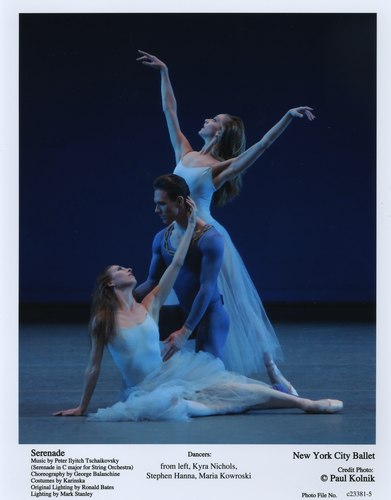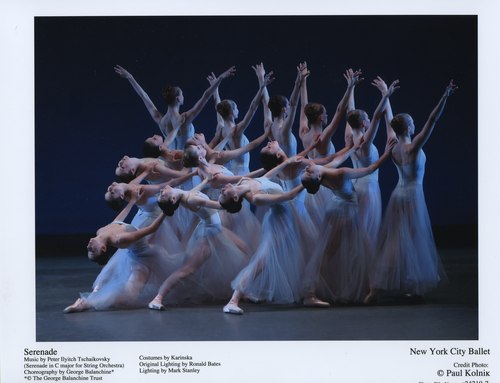George Balanchine's Serenade
 |
| Sacramento Ballet. Photo by Mark Zablotzky. |
Serenade is a milestone in the history of dance. It is the first original ballet George Balanchine created in America and is one of the signature works of New York City Ballet’s repertory. Balanchine began the ballet as a lesson in stage technique and worked unexpected rehearsal events into the choreography. A student’s fall or late arrival to rehearsal became part of the ballet. After its initial presentation, Serenade was reworked several times. In its present form there are four movements—“Sonatina,” “Waltz,” “Russian Dance,” and “Elegy.” The last two movements reverse the order of Tschaikovsky’s score, ending the ballet on a note of sadness. Balanchine had a special affinity for Tschaikovsky. “In everything that I did to Tschaikovsky’s music,” he told an interviewer, “I sensed his help. It wasn’t real conversation. But when I was working and saw that something was coming of it, I felt that it was Tschaikovsky who had helped me.”

Over the course of my training and professional career, I have had the pleasure of performing this wonderful work more than four times. Each experience held in it a special magic that was unique, either because of the wonderful insights and stories brought by the repetiteur setting the ballet, the city and studio environment, or the difference in the particular spot I was assigned to dance.
One of the joys for me about dancing this ballet is that every single role is required to dance to the fullest that their soul and body will allow. The music invokes an almost ethereal and poignant moment of urgency for those onstage and off. One is never discouraged or asked to dance less than their full presence, for each dancer is an integral part of this fine work of choreography.
There are many rumors and tales of Serenade having bits and pieces of a storyline. The official word is that the piece is abstract, but my experience has been that the ballet is undeniably fraught with moments of tension, climax, resolution and character development--even if there is no overarching theme.
Another charming quality of this particular ballet is that several of the key moments were inspired by real-life imperfections; a girl running in late to rehearsal, another dancer tripping and falling to the floor--these things have all become part of the fiber of this stunning work.
Everything about this ballet is exhilarating--from the pale blue costumes caught in fractured light through the wings, to the formations that move as swiftly and as beautifully as water, to the sense of solidarity felt by the entire body of dancers as they are whisked across the stage by Tchaikovsky's score--which should always be punctuated by passion-filled eruptions of light blue tulle.


Comments
Post a Comment